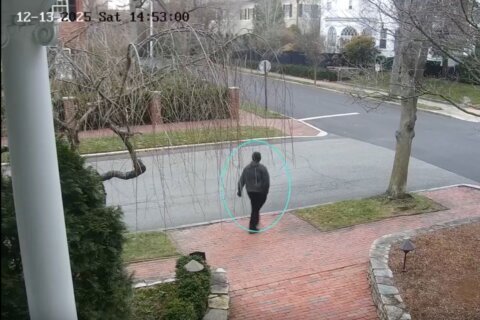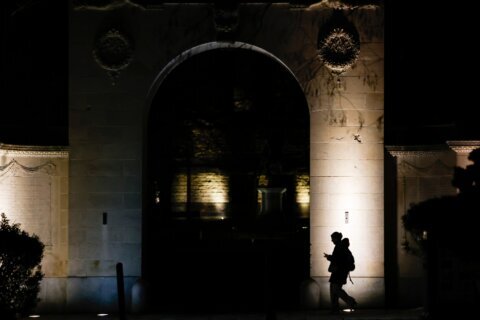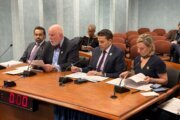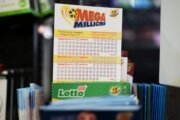From vaping to the cost of supplies and cellphone policies, the WTOP team is studying up on hot-button topics in education across the D.C. region. Follow our series “WTOP Goes Back to School” on air and online this August and September.
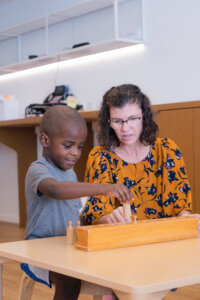
During the final minutes of the second day of school at Blue Montessori in D.C.’s Anacostia neighborhood last week, about a dozen students gathered on the carpet for what school leaders described as community time.
Sometimes there’s dancing too, and the gathering provides a final opportunity for students to interact before they either head home or to aftercare. An apprehensive mother watched the afternoon’s final moments and started to cry.
She was nervous about coming into the school, and for the first time, watched her child interact with several other kids. Her daughter was new to the school, and the mom was worried about how she’d behave around other kids in a formal setting.
But as she looked on, the girl was smiling and other kids were helping her.
“What she noticed is that her daughter is fitting in, and even on the second day, is already making friends and having positive interactions with her teachers and her classmates,” said Jordan Kerstetter, teacher-leader at Blue Montessori.
Blue Montessori is one of several “microschools” in the D.C. region. Microschools usually serve a small group of students of various ages, offering them support in an untraditional environment. In some cases, there’s not much regulation, and educators get to work on and implement the curriculum. Lessons typically involve field trips, too.
Some microschools host students from kindergarten through high school, while others are catered to a specific age group. They’ve become increasingly popular since the pandemic, and there are just under 100,000 microschools in the U.S., according to the advocacy group National Microschooling Center.
Blue Montessori just opened its doors to a dozen students last week. It’s a D.C. Wildflower Public Charter School, and it’s hoping to get 15 to 20 kids fully enrolled before October. It’s serving pre-K students, and will eventually enroll kindergartners.
“Parents are coming to us because they want a smaller classroom size for their child, but they’re staying because it’s a smaller school for the parent,” said Clifford Bussie, teacher-leader at Blue Montessori.
More back-to-school stories:
- School districts across DC region return to class
- Most kids who vape want to quit. Why don’t they?
- Proposed policy would prohibit student cellphone use at elementary and middle schools in Arlington
- Fairfax Co. expands cellphone storage pilot program to include 9 high schools
‘Opportunity to listen’
Formal microschools can be set up in different ways. They can be established as private schools, which can be accredited or unaccredited. Microschools may also be launched as learning hubs that follow a given state’s home schooling rules.
Some are opened by licensed teachers, others are launched by parents.
Microschools serve an average of about 16 students, according to Don Soifer, CEO of the National Microschooling Center. They’re deliberately small to enable educators to get to know their students.
Depending on funding models, they can either charge tuition or operate as a public charter school to receive state-level funding.
“In microschools, kids have the opportunity to listen, to be heard, to be seen and to participate in meaningful ways,” Soifer said.
“Very often, when microschools are smaller, they have more opportunities to build meaningful relationships with their educators and with the other kids in their microschool because microschools have the flexibility, because they don’t have the rigidities that more traditional, larger systems have. Kids don’t waste a lot of time during the day.”
As Blue Montessori evolves, for example, it’s planning to enroll a maximum of 28 to 30 students. The small class sizes allow educators to be flexible in each day’s schedule, adjusting plans based on a student’s needs.
In some cases, microschooling can also be considered a type of homeschooling. Parents of students who are attending certain microschools may indicate they’re homeschooling their child, according to Dr. Kellie Rolstad, an associate professor in the University of Maryland’s College of Education.
A parent may be responsible for overseeing that process for their own children or others in the community, and in some cases, they might hire a licensed teacher to do it. In those cases of more informal microschooling, two days of the week are usually dedicated to academics. The rest of the time, students are playing, socializing or pursuing projects they’re interested in, Rolstad said.
“We tend to think of the curriculum at school as requiring seven hours a day, five days a week, but it doesn’t,” Rolstad said.
‘We pay attention’
This video is no longer available.
When Siri Fiske opened MYSA School in Bethesda in 2016, she started with a focus on customized and individualized learning for each student. The school charges tuition, but has received grant funding because it’s operating as a nonprofit.
At the time, students spent one-third of the week outside the classroom, taking yoga or kickboxing classes and exploring new ways to learn outside a traditional classroom. Now operating in D.C., MYSA welcomes between 20 to 60 students, depending on the year. It’s been K-12 up until this year, and the school uses the same standards that public schools use.
MYSA went through the accreditation process last year. It groups students differently, and requires them to show they’ve actually learned something before getting credit for it.
“If we have a student who is in seventh or eighth grade and they’re interested in U.S. history, then … they can study that,” Fiske said. “If they’re motivated and want to learn that, there’s no reason that they have to wait until a specific time.”
For some students, the goal of attending a microschool is to help them socialize or catch up academically before returning to a different public or private school. Others may remain on a less common track outside a traditional school before attending college or launching a career.
“Every kid could use that, right? A place where, if you miss school, it’s noticed,” Fiske said. “The kids at our school, if they don’t come to school, we notice it. We pay attention. We know what’s happening with their family. We know when they’re in a bad mood.”
Personalization makes a difference
At the Grand Magnolia School in Richmond, Natalie Summerville has taken a similar approach. She won’t work with more than 12 students, and the current crop of 10 ranges from 4 to 10 years old. Every child has a list of skills they’re working on.
Sometimes, a student may be less interested in math and more interested in creating a comic strip, which can serve as a language arts lesson. Every day, students participate in an excursion, whether it’s to a zoo, museum or splash park.
“We’re learning how to talk with one another,” Summerville said. “We have a very strong program based on, ‘How are you going to develop an understanding of your feelings and emotions, and how do you convey them to others?'”
Her students pay tuition to attend, and she works with another teacher and hosts mentees doing internships during their time as students at local colleges and universities.
The personalization makes a difference, she said.
“People are looking for an environment where their children are seen and heard,” Summerville said. “And what I mean by that is that if you can imagine children in a classroom with 24 to 32 children and a teacher who’s trying to address that, either alone or with maybe one aide, it’s very difficult for many children to feel like that’s a good place for them.”
Finding a ‘flow state’
At Blue Montessori, meanwhile, the schedule is catered to students’ needs. School goes from 8 a.m. to 3 p.m., and if students need a movement break, the schedule affords them the flexibility to do so.
In the morning, the microschool uses a three-hour work cycle. They find the materials and start working, while Kerstetter and Bussie offer support.
“It’s a three-hour work cycle because we want children to be able to achieve that flow state that we all kind of yearn for as adults, where we really don’t want to be interrupted,” Bussie said.
Then, the students meet on the carpet around 11 a.m., singing songs and reading a book. Afterward, they spend about 45 minutes outside. That’s followed by lunch and a nap, and around dismissal time, there may be time to dance.
Because Blue Montessori is part of a public charter school in D.C., it receives funding from the city. There are milestones that each charter school has to hit, and older students do take standardized tests.
“We don’t have a traditional school building full of classrooms and kids and schedules,” Kerstetter said. “We get to choose what we want for our kids.”
As the concept of microschools evolves, Fiske and MYSA said many of the newest are chains and are for-profit. Sometimes, they don’t want to go through the accreditation process and have little oversight.
“These little schools that are starting, it’s great in some ways,” Fiske said. “Sort of nationally, there’s no oversight, and depends on the state, but there’s often not a lot of oversight. I think that’s something to sort of keep an eye on just as this is unfolding.”
Get breaking news and daily headlines delivered to your email inbox by signing up here.
© 2024 WTOP. All Rights Reserved. This website is not intended for users located within the European Economic Area.



